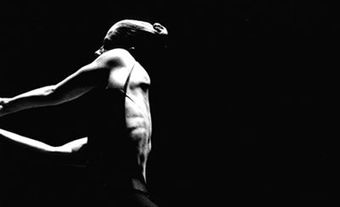Ginette Laurin
Ginette Laurin, dancer, choreographer, artistic director (b at Montréal 3 Jan 1955). Ginette Laurin studied ballet, jazz, modern dance and mime in addition to gymnastics, and became a prime mover in GROUPE NOUVELLE AIRE after 1977, dancing many roles created by fellow dancers Édouard LOCK, Paul-André FORTIER, Daniel Léveillé and Daniel Soulières, who, like her, were destined to lead the Québec contemporary dance movement. She also danced for Québec dance pioneers Françoise SULLIVAN and Françoise Riopelle, as well as for Jean-Pierre PERREAULT. Her interpretive skills were much sought after between 1978 and 1984, and she toured Europe, the Middle East and Canada in a variety of roles.Laurin began her own choreographic career in 1979 with Sept fois passera. In 1984 she founded her own company, O Vertigo Danse, creating works exemplifying humour, physicality and risk-taking, such as Olé and Crash Landing. Almost immediately the company began touring Europe. Within 2 years O Vertigo had appeared at the prestigious Bagnolet festival in France, the Festival international de nouvelle danse in Montréal and Expo 86, for which she created Chevy Dream (1986). She was awarded the Jean A. Chalmers prize the same year.
"My dance is about vertigo, the allure of the abyss, exhilaration, free-falling emotion," Laurin has written. To this end she has created 40 works which, until recently, have concentrated on dizzyingly energetic theatricality. En Dedans, recreated in 1998 for her company of 10 dancers from a smaller work of the same name commissioned by the city of Munich, Germany, took a giant step away from daredevil physicality to explore the trance-like interior world of spirituality, a direction suggested in Déluge in 1994. Laurin's largest work, La Vie qui bat (1999), for 20 dancers and musicians from the Société de musique contemporaine du Québec, was set to Steve Reich's 90-minute composition, Drumming. It premiered in Montréal in 1999. Two years later, Laurin premiered the poetic Luna, which uses optical technology to distort the human form and project it as landscape to be explored in infinite detail.
Since 2000, her works have become more internal and pensive as exemplified in 2007 by Étude #3 pour cordes et poulies. Inspired by author Samuel Beckett's treatment of the body, Études explores a universe where humans are bound and tossed to the rhythm of words.
An increased interest in multimedia and an abiding emphasis on sharing artistic experiences led Ginette Laurin to mark the 20th anniversary of her company in 2004 with The Resonance of the Double, a series of 6 installations combining dance, photography and video. Laurin's hands-on fascination with photography and video has been evident in her most recent works.
Since founding a creation centre in the heart of Montréal at Place des Arts in 2005, she has promoted her company's creation and research mandate in the state-of-the-art studios at the Centre de Création O Vertigo by holding labs and workshops and stimulating collaboration with artists involved in lighting, sound, theatre and architecture as well as dance.
Always involved in training and development, Laurin also teaches regularly at the Université du Québec à Montréal (UQAM) and at European festivals.
O Vertigo tours extensively on international circuits in Asia, the Middle East and Europe, appearing regularly at festivals in Holland, Germany and Italy in particular as well as in New York, Ottawa and Montréal. Laurin's installations often tour independently.
Laurin has created works for LES GRANDS BALLETS CANADIENS de Montréal, MONTRÉAL DANSE, The Judith MARCUSE Dance Project Society, Holland's Introdans, and Argentina's Ballet contemporáneo de San Martin as well as for such independent dancers as Gioconda Barbuto, Kathy Casey and Sylvain Lafortune. She has choreographed for several films for cinema and television, including Night of the Flood (inspired by Déluge), La Chambre blanche, September Songs: The Music of Kurt Weill and Dans, Tanz, Dance, Danse. Déluge and La Bête (The Beast Within) have had increased exposure in compact discs featuring music by Jocelyn Pook and Jean Derome, respectively.
Curious and adaptable, Laurin began directing films of her own in early 2000, inspired by or based on her stage productions. Passare took the award for best direction at Toronto's Moving Pictures Festival in 2003, and her feature film, Wire Frame, won best Canadian work at the International Festival of Films on Art in Montréal in 2006. At the same time, with an almost uncanny ability to invent new choreographic vocabulary and style to enhance her always diverse themes, she added Angels (2006), Études pour cordes et poulies (2007) and Onde de choc (2009) to her body of staged work, and recreated 2 earlier works: La Chambre blanche and La Vie qui bat. All had long international exposures. Chambre toured Europe 5 times after opening for 3 weeks in Montréal.
Ginette Laurin holds awards including the 1999 recognition prize and the 1998 and 1992 grand prizes from the Conseil des arts de la Communauté urbain de Montréal, as well as the 1986 Jean A. Chalmers Award, the 1994 Dora Mavor Moore Prize and UQAM's 2002 Prix de reconnaissance.

 Share on Facebook
Share on Facebook Share on X
Share on X Share by Email
Share by Email Share on Google Classroom
Share on Google Classroom


